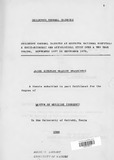| dc.contributor.author | Maleche, Jacob S | |
| dc.date.accessioned | 2013-05-23T09:24:20Z | |
| dc.date.available | 2013-05-23T09:24:20Z | |
| dc.date.issued | 1980 | |
| dc.identifier.citation | Masters of Medicine (Surgery) | en |
| dc.identifier.uri | http://erepository.uonbi.ac.ke:8080/xmlui/handle/11295/24763 | |
| dc.description.abstract | Burns (Thermal) injury is a common cause of
admission to the hospital. All age groups are affected.
Majority of thermal injuries do occur in chl1dre. below
fifteen years of age. The symptoms of thermal injuries
are obvious. The physical signs and diagnosis are made
by seeing the patient. There is little confusion
between burns injuries and other diseases.
Thermal injuries are taken for grated by all
those who manage these patients. The patients are
usually admitted, treated and discharged home and no
more is thought about the root cause of this disease.
few people realise the long term effects of thermal
injuries to those affected. Ia our set up we rarely
follow up those patients to be able to evaluate their
disabilities arising from the burn's injuries. With
this in mind I therefore undertook this study to prove;
(1) that for every child admitted to hospital
with a thermal injury, there .a~ be social
factors beh1ad his accident.
(ii) that economic factors are involved in the
causation of burns injuries.
(iii) that thermal injuries are largely preventable.
In my two year prospective study I analysed various
social circumstances that surround these patients. I
also analysed the causative factors of these accidents
1a detail. The study was carried on two hundred and
eighty-four children admitted to the Burns Unit at Kenyatta National Hospital. All the patients analysed
were between one year and fifteen year of age.
60.2% of the patients were males and 39.8% were
females. 96% of all the patient8 reported to hospital
within twenty-four hours from the time of injury. The
remaining four per cent were delayed, because of difficulty
in transport, or because they went to another
hospital or health unit but later were transferred to
Kenyatta National Hospital. The study has shown the
various causes of burns and has revealed that certain
age groups of children have a higher risk than the rest
of the population. The study has highlighted the areas
in the house and in the community where thermal injuries
are likely to occur. It i8 8hown that males tend to be
more prone to injury as compared to the females, the
ratio of 2 I 1. Toddlers are likely to get scalds in
the kitchen or dining hall, while the other age groups
receive flame burns outside the house. Thermal injuries
are more common in the large and congested family units.
The study has a180 8hown clearly that m08t children
receive burn8 at the time when there is no responsible
adult pre8ent. This is relevant to our society because
most children are left at home under the care of other
children. The nature of work of the mother does influence
the incidence of thermal injuries. 68.6% of all the
mothers who~children were burnt were full-time employed.
The study has revealed clearly that thermal injuries
are very prevalent in low income earners and the unemployed.
7 of all the children burnt came from this
group.
Thermal injuries are a public risk, there is a need
for a National prevention programme for thermal injuries.
Education of the whole population and legislation to
protect fire heaters and other place8 would be a big
step in reducing the mortality and mobidity of this | en |
| dc.language.iso | en | en |
| dc.publisher | University of Nairobi | en |
| dc.title | Childhood Thermal Injuries At Kenyatta National Hospital. A Socio-economic And Aetiological Study Over A Two Year Period. | en |
| dc.type | Thesis | en |
| dc.description.department | a
Department of Psychiatry, University of Nairobi, ; bDepartment of Mental Health, School of Medicine,
Moi University, Eldoret, Kenya | |
| local.publisher | School of Medicine | en |

